2004 FORD MUSTANG spare wheel
[x] Cancel search: spare wheelPage 130 of 240

Fuse/Relay
LocationFuse Amp
RatingPower Distribution Box
Description
13 30A* MACH 1000 left amplifiers
14 20A* Fuel pump
15 30A* MACH 1000 right amplifiers
16 20A* Horn
17 20A* ABS
18 30A* Power seats
19 10A* Intercooler pump (Cobra
only)
20 20A* Alternator
21—Not used
22—Not used
23—Not used
24 20A* A/C pressure
25—Not used
26 30A** PCM
27 20A** Daytime Running Lamps
(DRL) module, Foglamp
relay
28 25A CB Convertible top circuit
breaker
29—Not used
* Mini Fuses ** Maxi Fuses
CHANGING A FLAT TIRE
If you get a flat tire while driving:
•do not brake heavily.
•gradually decrease the vehicle’s speed.
•hold the steering wheel firmly.
•slowly move to a safe place on the side of the
road.
The use of tire sealants may damage your
tires.
Temporary spare tire information
Your vehicle may have a temporary spare tire which
is labeled as such. It is smaller than a regular tire
2004 Mustang(mus)
Owners Guide (post-2002-fmt)
USA English(fus)
Roadside Emergencies
130
Page 131 of 240
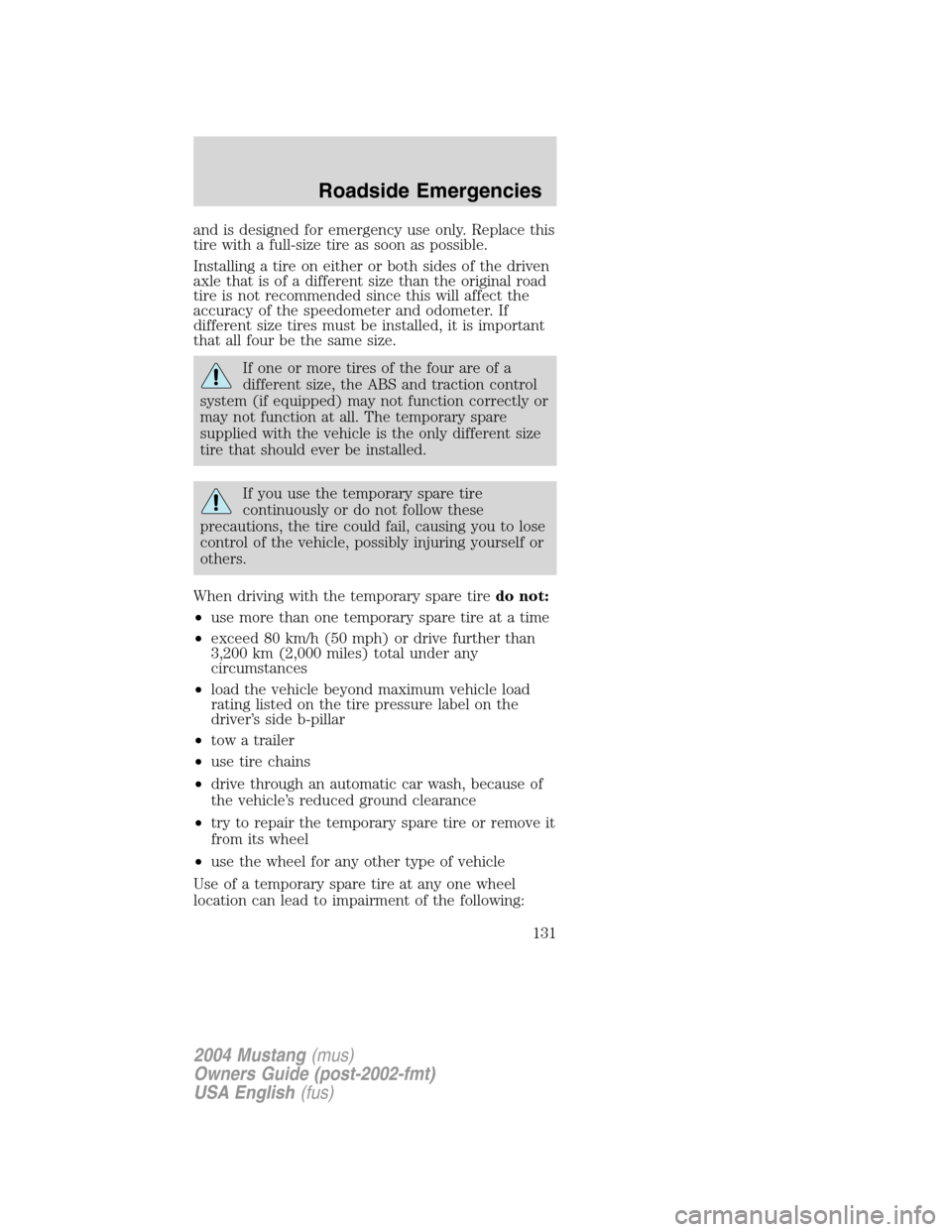
and is designed for emergency use only. Replace this
tire with a full-size tire as soon as possible.
Installing a tire on either or both sides of the driven
axle that is of a different size than the original road
tire is not recommended since this will affect the
accuracy of the speedometer and odometer. If
different size tires must be installed, it is important
that all four be the same size.
If one or more tires of the four are of a
different size, the ABS and traction control
system (if equipped) may not function correctly or
may not function at all. The temporary spare
supplied with the vehicle is the only different size
tire that should ever be installed.
If you use the temporary spare tire
continuously or do not follow these
precautions, the tire could fail, causing you to lose
control of the vehicle, possibly injuring yourself or
others.
When driving with the temporary spare tire do not:
• use more than one temporary spare tire at a time
• exceed 80 km/h (50 mph) or drive further than
3,200 km (2,000 miles) total under any
circumstances
• load the vehicle beyond maximum vehicle load
rating listed on the tire pressure label on the
driver’s side b-pillar
• tow a trailer
• use tire chains
• drive through an automatic car wash, because of
the vehicle’s reduced ground clearance
• try to repair the temporary spare tire or remove it
from its wheel
• use the wheel for any other type of vehicle
Use of a temporary spare tire at any one wheel
location can lead to impairment of the following:
2004 Mustang (mus)
Owners Guide (post-2002-fmt)
USA English (fus)
Roadside Emergencies
131
Page 133 of 240

To change the tire:
Note:Passengers should not remain in the vehicle
when the vehicle is being jacked.
1. Block both the front
and rear of the wheel
diagonally opposite the
flat tire. For example,
if the left front tire is
flat, block the right rear wheel.
2. Remove the spare
tire, jack and lug
wrench.
3. Remove the center
ornament (if equipped)
from the wheel. Loosen
each wheel lug nut
one-half turn counter-
clockwise but do not
remove them until the
wheel is raised off the
ground.
4. Put the jack in the
jack notch next to the
tire you are changing.
Turn the jack handle
clockwise until the
wheel is completely off
the ground.
2004 Mustang (mus)
Owners Guide (post-2002-fmt)
USA English (fus)
Roadside Emergencies
133
Page 134 of 240
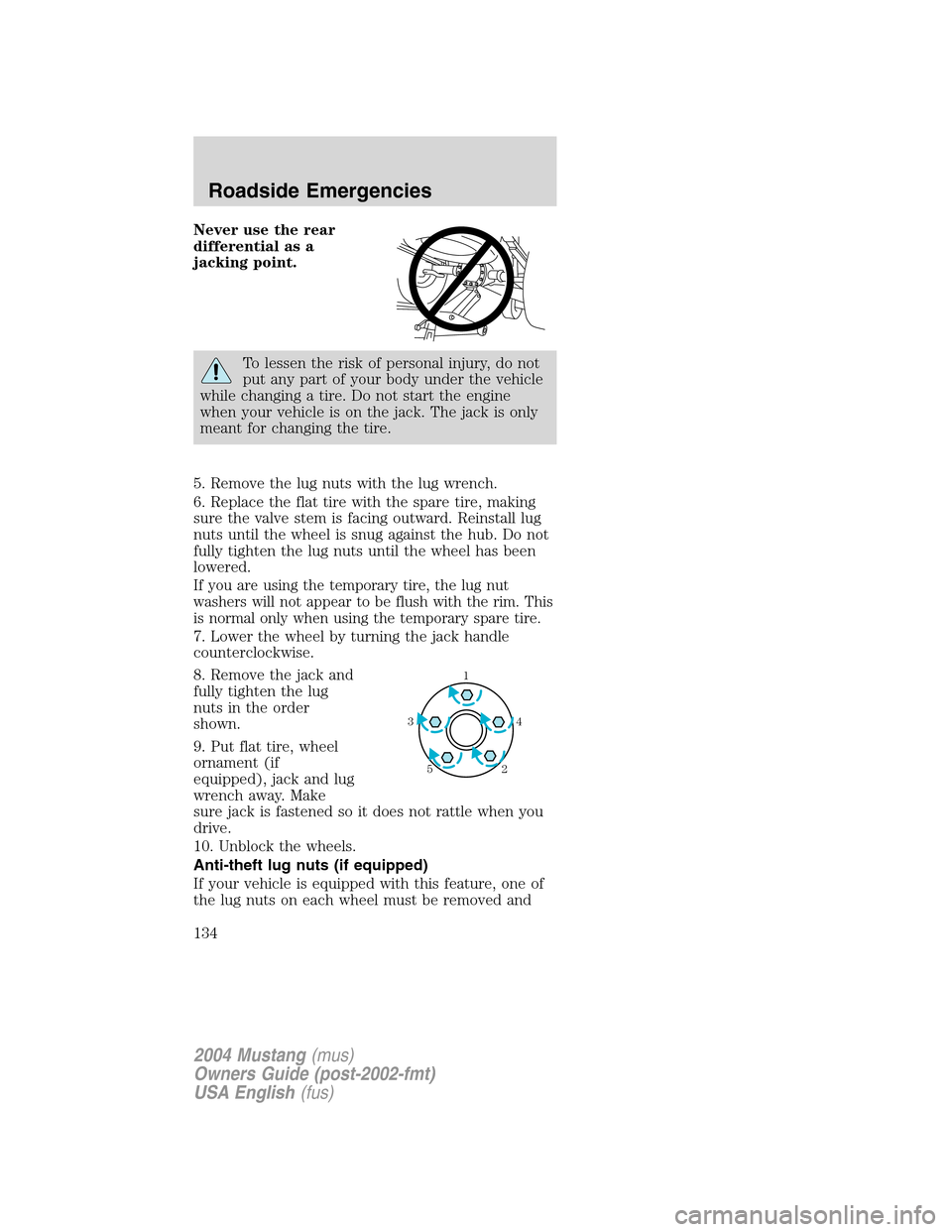
Never use the rear
differential as a
jacking point.
To lessen the risk of personal injury, do not
put any part of your body under the vehicle
while changing a tire. Do not start the engine
when your vehicle is on the jack. The jack is only
meant for changing the tire.
5. Remove the lug nuts with the lug wrench.
6. Replace the flat tire with the spare tire, making
sure the valve stem is facing outward. Reinstall lug
nuts until the wheel is snug against the hub. Do not
fully tighten the lug nuts until the wheel has been
lowered.
If you are using the temporary tire, the lug nut
washers will not appear to be flush with the rim. This
is normal only when using the temporary spare tire.
7. Lower the wheel by turning the jack handle
counterclockwise.
8. Remove the jack and
fully tighten the lug
nuts in the order
shown.
9. Put flat tire, wheel
ornament (if
equipped), jack and lug
wrench away. Make
sure jack is fastened so it does not rattle when you
drive.
10. Unblock the wheels.
Anti-theft lug nuts (if equipped)
If your vehicle is equipped with this feature, one of
the lug nuts on each wheel must be removed and
1
4
3
2
5
2004 Mustang (mus)
Owners Guide (post-2002-fmt)
USA English (fus)
Roadside Emergencies
134
Page 135 of 240

replaced with a special key. The key and registration
card are attached to the lug wrench and stored with
the spare tire. If you lose the key, send the
registration card to the manufacturer (not the
dealer) to get a replacement key. If the lug
wrench/lug nut key assembly is lost, see your
nearest Ford or Lincoln Mercury dealer who has
access to the master set of keys.Do not use an
impact wrench with the anti-theft key.
To remove the
anti-theft lug nut:
1. Insert the key over
the locking lug nut.
Make sure you hold the key square to the lug nut. If
you hold the key at an angle, you could damage the
key and the lug nut.
2. Place the lug nut wrench over the lug nut key and
apply pressure on the key with the wrench.
3. Turn the wrench in a counterclockwise direction
to remove the lug nut.
To install the anti-theft lug nut:
1. Insert the key over the locking lug nut.
2. Place the lug nut wrench over the lug nut key and
apply pressure on the key with the wrench.
3.
Install the lug nut by turning the wrench clockwise.
Wheel lug nut torque specifications
Retighten the lug nuts to the specified torque at
800 km (500 miles) after any wheel disturbance
(tire rotation, changing a flat tire, wheel removal,
etc.).
Bolt size Wheel lug nut torque*
Nm Lb-ft
1⁄2x 20 120-147 88-108
* Torque specifications are for nut and bolt threads free of
dirt and rust. Use only Ford recommended replacement
fasteners.
2004 Mustang (mus)
Owners Guide (post-2002-fmt)
USA English (fus)
Roadside Emergencies
135
Page 208 of 240
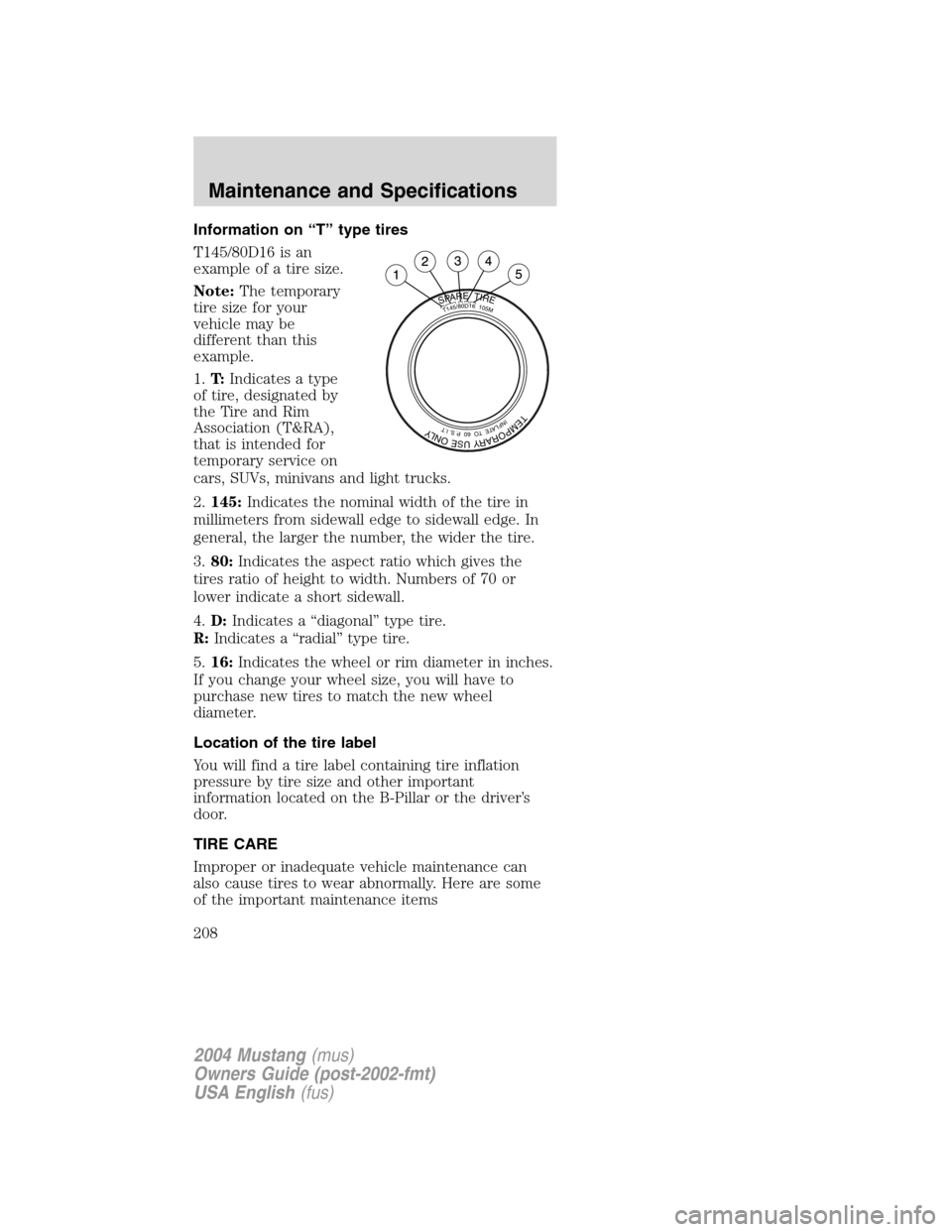
Information on“T”type tires
T145/80D16 is an
example of a tire size.
Note:The temporary
tire size for your
vehicle may be
different than this
example.
1.T:Indicates a type
of tire, designated by
the Tire and Rim
Association (T&RA),
that is intended for
temporary service on
cars, SUVs, minivans and light trucks.
2.145:Indicates the nominal width of the tire in
millimeters from sidewall edge to sidewall edge. In
general, the larger the number, the wider the tire.
3.80:Indicates the aspect ratio which gives the
tires ratio of height to width. Numbers of 70 or
lower indicate a short sidewall.
4.D:Indicates a“diagonal”type tire.
R:Indicates a“radial”type tire.
5.16:Indicates the wheel or rim diameter in inches.
If you change your wheel size, you will have to
purchase new tires to match the new wheel
diameter.
Location of the tire label
You will find a tire label containing tire inflation
pressure by tire size and other important
information located on the B-Pillar or the driver’s
door.
TIRE CARE
Improper or inadequate vehicle maintenance can
also cause tires to wear abnormally. Here are some
of the important maintenance items
SPARETIRE
TEMPORARYUSEONLYINFLATETO60P.S.I.T
T145/80D16105M
2004 Mustang(mus)
Owners Guide (post-2002-fmt)
USA English(fus)
Maintenance and Specifications
208
Page 210 of 240
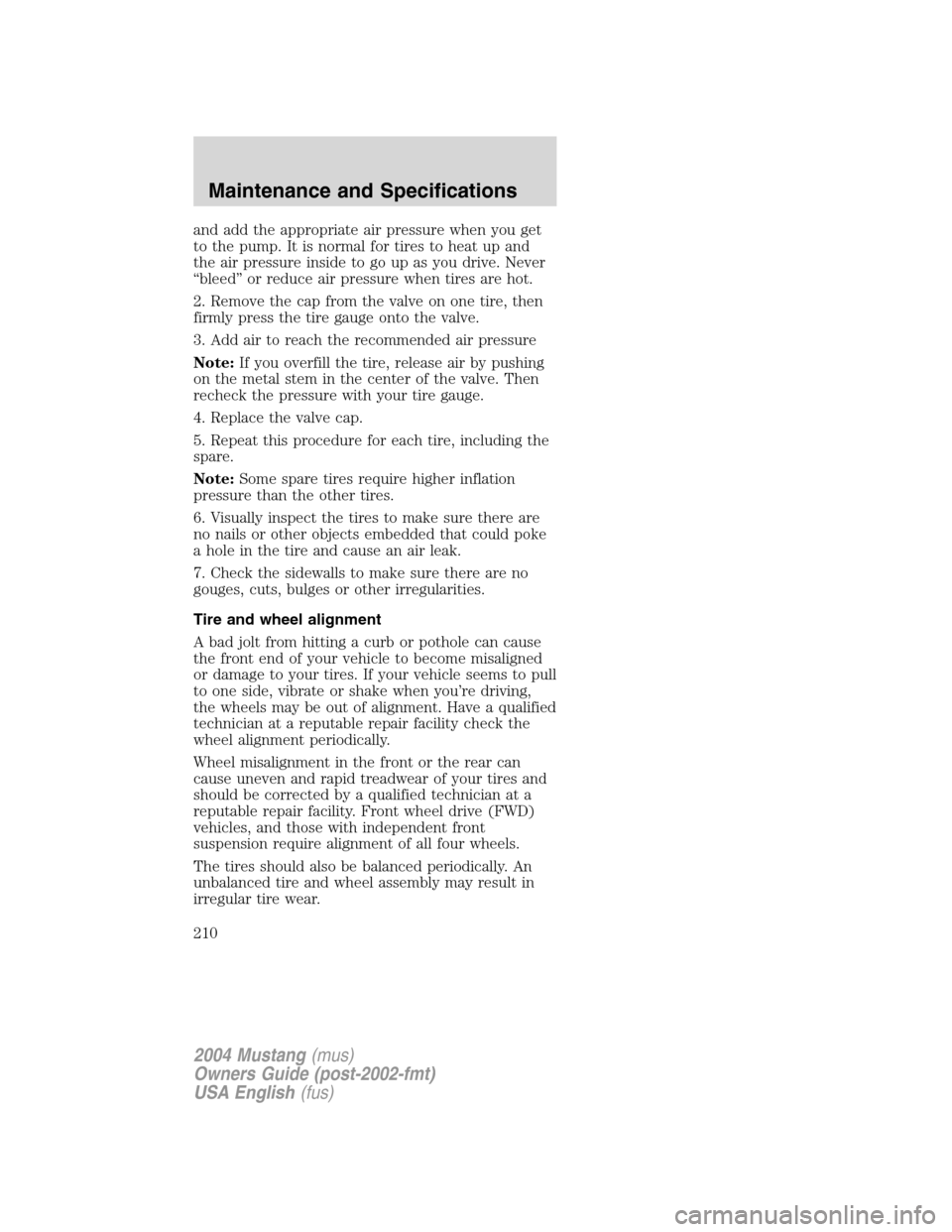
and add the appropriate air pressure when you get
to the pump. It is normal for tires to heat up and
the air pressure inside to go up as you drive. Never
“bleed”or reduce air pressure when tires are hot.
2. Remove the cap from the valve on one tire, then
firmly press the tire gauge onto the valve.
3. Add air to reach the recommended air pressure
Note:If you overfill the tire, release air by pushing
on the metal stem in the center of the valve. Then
recheck the pressure with your tire gauge.
4. Replace the valve cap.
5. Repeat this procedure for each tire, including the
spare.
Note:Some spare tires require higher inflation
pressure than the other tires.
6. Visually inspect the tires to make sure there are
no nails or other objects embedded that could poke
a hole in the tire and cause an air leak.
7. Check the sidewalls to make sure there are no
gouges, cuts, bulges or other irregularities.
Tire and wheel alignment
A bad jolt from hitting a curb or pothole can cause
the front end of your vehicle to become misaligned
or damage to your tires. If your vehicle seems to pull
to one side, vibrate or shake when you’re driving,
the wheels may be out of alignment. Have a qualified
technician at a reputable repair facility check the
wheel alignment periodically.
Wheel misalignment in the front or the rear can
cause uneven and rapid treadwear of your tires and
should be corrected by a qualified technician at a
reputable repair facility. Front wheel drive (FWD)
vehicles, and those with independent front
suspension require alignment of all four wheels.
The tires should also be balanced periodically. An
unbalanced tire and wheel assembly may result in
irregular tire wear.
2004 Mustang(mus)
Owners Guide (post-2002-fmt)
USA English(fus)
Maintenance and Specifications
210
Page 212 of 240
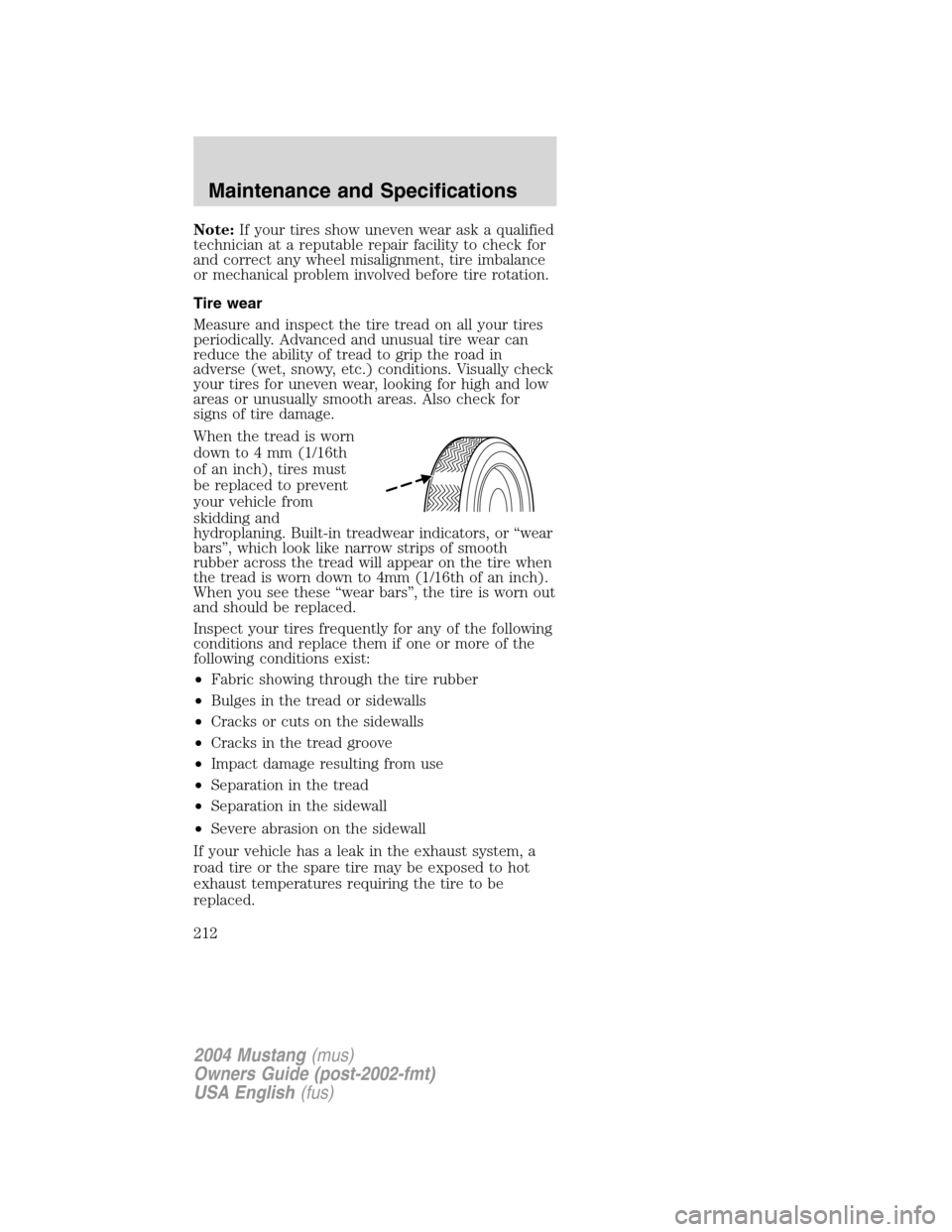
Note:If your tires show uneven wear ask a qualified
technician at a reputable repair facility to check for
and correct any wheel misalignment, tire imbalance
or mechanical problem involved before tire rotation.
Tire wear
Measure and inspect the tire tread on all your tires
periodically. Advanced and unusual tire wear can
reduce the ability of tread to grip the road in
adverse (wet, snowy, etc.) conditions. Visually check
your tires for uneven wear, looking for high and low
areas or unusually smooth areas. Also check for
signs of tire damage.
When the tread is worn
down to 4 mm (1/16th
of an inch), tires must
be replaced to prevent
your vehicle from
skidding and
hydroplaning. Built-in treadwear indicators, or“wear
bars”, which look like narrow strips of smooth
rubber across the tread will appear on the tire when
the tread is worn down to 4mm (1/16th of an inch).
When you see these“wear bars”, the tire is worn out
and should be replaced.
Inspect your tires frequently for any of the following
conditions and replace them if one or more of the
following conditions exist:
•Fabric showing through the tire rubber
•Bulges in the tread or sidewalls
•Cracks or cuts on the sidewalls
•Cracks in the tread groove
•Impact damage resulting from use
•Separation in the tread
•Separation in the sidewall
•Severe abrasion on the sidewall
If your vehicle has a leak in the exhaust system, a
road tire or the spare tire may be exposed to hot
exhaust temperatures requiring the tire to be
replaced.
2004 Mustang(mus)
Owners Guide (post-2002-fmt)
USA English(fus)
Maintenance and Specifications
212